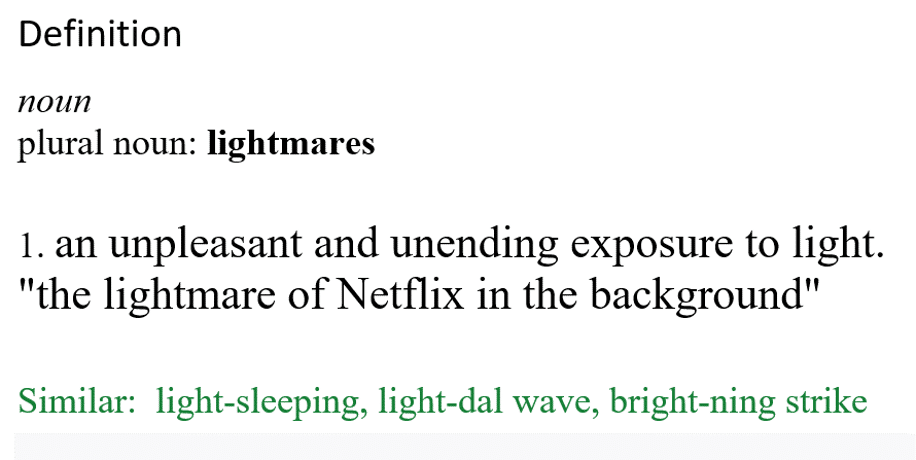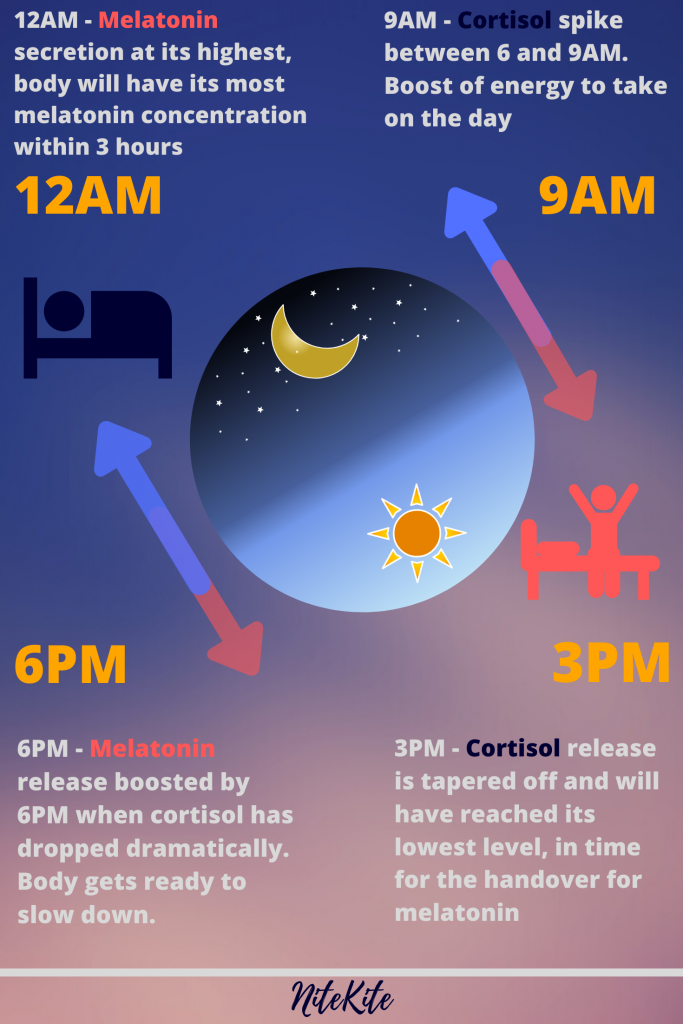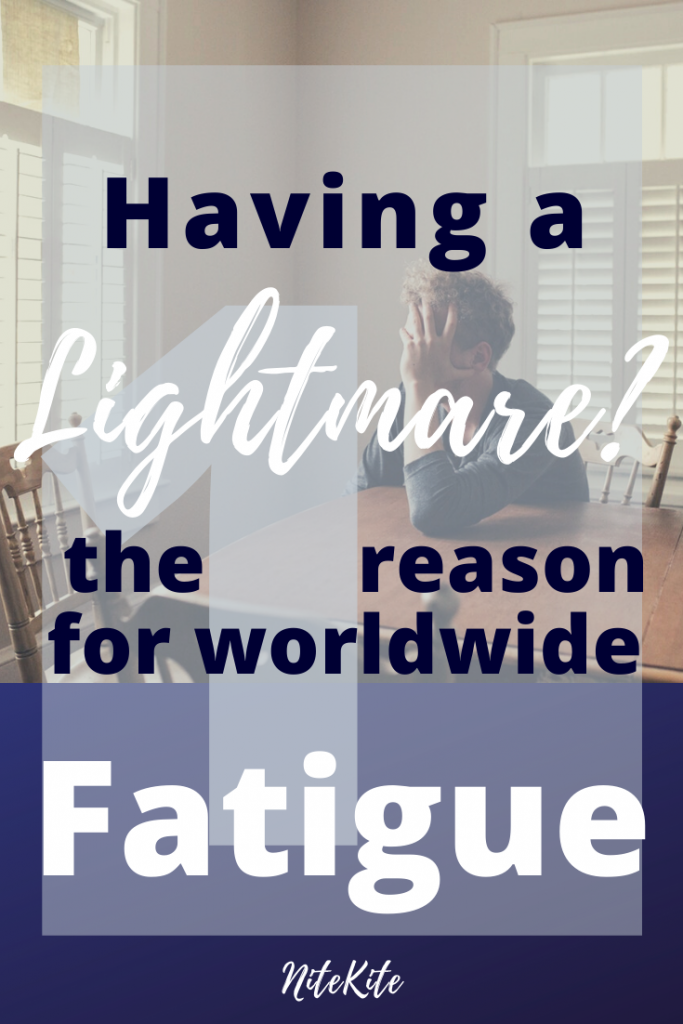What is a “Lightmare“?

A better way to approach that question would be what causes a “lightmare” well, any situation in which one finds themselves showered in unnatural lighting past daylight hours. Effectively, that means anytime past 8 or 9pm in most countries. It is the negative effect of light pollution on humans.
Why lightmares are important
While we did not in fact coin the term “lightmare” you can bet big money that you start seeing this term used increasingly in the near future, as we phase out other words/phrases – you know, like “bed time” and “rest”.
Are we finally at Y2K?
The 2020s will be the first decade where our “always” on culture has been perfected. There was a lot of anticipation for superior technology back in the late 90s going into the 2000s because of the fad of “Y2K” seemingly because it was the start of a new millennium, so we can’t be surprised at that – it was all very novel.
The 2010s was the prototype. We had just started changing the course of history at the end of the 2000s with the invention of Facebook and what would become “social media”, and with Twitter coming at the cusp of 2010, we were becoming more comfortable with it all.
But in the 2020s its been mastered. Everything is now in sync. Tech giants have valuations larger than small – and mid-sized – countries. Understanding and manipulating human psychology is part and parcel to the formula to get you to do one thing – Keep viewing.
Netflix streaming – episode after episode without having to lift a finger, “Scrolling” – through social media feeds, Instagram, Pinterest, Twitter – there is no end.
Do we ever stop to think about how actually view this content?

Blue light
Backlit screens are changing the way we live and almost certainly having a biological affect that we won’t notice for hundreds of years. But they will be there.
There is a pandoras box element to the introduction of this technology. More light allows us to work longer, do more, extend the day. A technology like that will never be “re-boxed” so to speak. But if we had to pinpoint the one thing that has created this sleep deprivation epidemic (sleep dep. Pin?/sleep dep post), the blame can go nowhere other than to the advent of the backlit screen.
It’s hard to imagine, but there was a time when as humans, we had to cease all activity when the sun went down. We’re fundamentally a daylight species after all. If we take the northern hemisphere, specifically the western portion for example, during winter, sundown is around 4pm. Until we used our brains to create fire and then light sources, most of the day was dark.
Today we look at that as a problem. But we lived in that way for hundreds of thousands of years – it is a part of us. For that reason the truth is likely that we don’t need more light – rather, we are supposed to be asleep for longer in the winter than in the summer months when the daylight hours increase.
We use artificial light for everything after the sun goes down without a second thought. In fact, our smartphone screens are lit during the day anyway. The working day consumes much of our time so there is a need to “reclaim” time – which we achieve by lighting up our cities and homes in and endless sea of high wave-length blue light at what is essentially the wrong time of day, when our bodies natural response is to wind down in accordance with reduced sunlight.
This is what brings us to the process (most scientists agree that it exists) of the Circadian Rhythm.
Circadian Rhythm
If you feel tired around the same time everyday, congratulations you have a circadian rhythm. If you wake up at similar times every day, congratulations, you have a circadian rhythm. Of course, this means without a “waking aid” – such as an alarm.
Your circadian rhythm is in simple terms a 24-hour internal clock that runs in the background of your brain cycling between the states of sleepiness and alertness, or wakefulness – which is why it’s also known as the sleep/wake cycle.
24 hour mystery
Everything we do has derived from our origins – we may have invented clocks, we may have invented the so called “24 hour day” – but we did not invent day and night. We are a product of that environment and our bodies have adjusted to work in 24 hour patterns – or better yet, one revolution on the Earth’s axis.
Studies have shown that this reaction to times of day is very real. So real, that disruption of the recommended 8 hour sleep time causes more extreme swings in sleepiness at the same times of day that our circadian rhythm would normally reduce our wakefulness.
For example, that internal clock increases sleepiness between 2:00am and 4:00am (when you’re fast asleep) and shortly after midday (the post-lunch food coma). These periods will be more intense when you haven’t slept well the night before. It is a good identifier of sleep deprivation for that reason.
What’s your Chronotype?
There are differences between people – it even determines whether you are morning person or a “night-owl”. The evidence suggests that night-owls experience 25 hour days and early-birds 23.5 hours days. Which one you identify with is officially known as your chronotype.

Melatonin – still bodies in darkness release melatonin faster
Melatonin works best when we aren’t doing anything, and when it is dark. Two things we’ve abandoned.
Hormones at the core of the sleep cycle are most adversely affected by our lifestyle adaptation to light pollution. The most well-known (It has become something of a fad in the sleep supplement industry) is melatonin. When it comes to the circadian rhythm, melatonin along with cortisol are the main players. 4 points summarise the link between melatonin and light:
The circadian rhythm works within the brain and adjusts process to light and dark surroundings.
Melatonin increases as it gets darker, usually between 3 and 6:00pm. This gets you ready for (your environmentally decided) bedtime.
Cortisol secretion increases in the morning, between 6 and 9:00am. This gives you the boost you need for daily activities.
bright, short-wavelength light–blue light–is the most efficient for suppressing melatonin
All of this new light is sending our melatonin cycle out of whack. And that has in turn lead to the rapid rise of a “sleep solution” industry intent on selling supplements that your body would produce, if you simply got enough sleep.
Sleep Solution Industry
This is one of the fastest growing areas of home improvement. We refuse to accept the fact that we need more. Nowadays, the economic cost is probably too high. Sleep experts have acknowledged, and in turn marketers are capitalising on the need for better quality sleep. Because that, we can do.
From cheap and effective sleep masks, designed to bring a personalised lighting experience your face (depending on the quality), to adjustable circadian lighting sets, you are not short on options for gadgets and gizmos that claim to promote healthier sleeping practices. The questions is really – do you know what you need?
With new research coming out daily the experts are discovering more about sleep at such a high rate that no 2 years have the same products, you can’t even say that for other tech industries (like the smart phone or TV market for example)
New Rules – 4 hours sleep…x2?
There are studies that have even shown we don’t need to sleep for 8 continuous hours – that at one point in our history we slept in 2 periods of 3 to 4 hours.
Circadian Lighting
Some of us have read about circadian lighting for years: the new lighting technologies that are tunable, biodynamic and sync with the time of day – all I the name of reducing the artificial light that we’re soaked in daily.
The market for circadian lighting is said to be worth $400 million dollars as of 2017 – with this number expected to rise to $4 billion by 2020.
Naturally we are finding ways to incorporate light that has less of a negative effect on our wellbeing. Aside from supplements the sheer amount of technology around sleep – from the “SOMNOX” robot to “Healthe”, developed with NASA scientists, and has a wireless control device that uses GPS (yes we are still talking about sleep) to track the positions of its “SunTrac” lightbulbs with the aim of simulating the natural arc of the sun throughout the day – you are not short on options.
Non-lighting solutions
While the sleep industry continues to grow, it begs the questions whether we can even increase the hours of sleep we get at all. We have too much to do, all of the time. Here at NiteKite we advocate for better quality sleep. Products such as dark eye-masks are non-invasive and serve up a dark screen right to your eyes to keep you asleep longer.
This is similar for weighted blankets – they are said to work well for increasing the quality of sleep experienced as they produce a sense of “immobilisation” that puts the body in a relaxed and comfortable state. By using a blanket with more weight, the body will be at ease which will speed up the secretion of the melatonin and the “happy” hormone, serotonin for better quality of sleep – even if it is for a shorter period of time.

Have you had any experience with “lightmares”, bad quality sleep and general sleep deprivation? What solutions have you tried?





